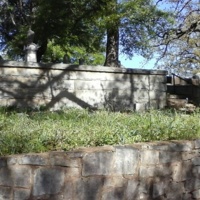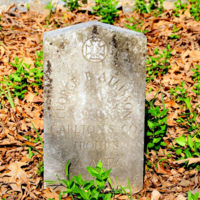Dr. George Baber Atkisson
Dublin Core
Title
Dr. George Baber Atkisson
Subject
Dr. George Baber Atkisson
Description
George Baber Atkisson was born on September 14, 1843 in Virginia. He attended school at UGA, class of 1861. He enlisted into the Confederate military artillery unit called Troup Artillery.
Plot WH71
Plot WH71
Creator
Jacob Richardson
Contributor
Shelby Brown
Coverage
Dr. George Baber Atkisson currently occupies a plot with his family at the Historic Oconee Hill Cemetery in plot number WH71. He was born on September 14, 1843, in Virginia. Later, he attended school at UGA, class of 1861. He then enlisted into the Confederate military artillery unit called Troup Artillery, originally named The National Artillery also in 1861. Troup Artillery was based in Athens, Georgia until 1861 when they left for Savannah, Georgia. There they drilled for two months at Fort Pulaski, the military base on Tybee Island. Fort Pulaski, because of its location, had a problem with the heat and as a result, many of the soldiers had been struck with heat stroke. George B. Atkisson made it through the training and by July, the regiment had left Savannah and was moved to Richmond Virginia. His regiment remained in Virginia but soon became part of the Cobb’s Legion in Yorktown where George B. Atkisson became an officer.
On September 17, 1862, he was shot in Battle of Antietam in Sharpsburg, Maryland and was the first battle of the Civil War to take place on northern soil. The battle ended in a draw that was only slightly in the Union’s favor by stopping the Confederate advance. It is known as the bloodiest day in American history with more than 22,000 dead by the end of the battle. George B. Atkisson was shot in the thigh during the battle and was sent to Shepardstown to recover from his wounds. He was stationed along the Potomac River in West Virginia and was given Garrison Duty instead of active duty because of his injuries. He remained on active duty for the next two years, moving around Virginia and eventually was stationed back in Georgia.
He was retired from active duty in 1864 and was “subject to call” the end of the war according to his obituary printed in the Banner Herald’s article “Death Claims Dr. Geo. B. Atkisson.” Afterwards, he attended medical school at the Atlanta Medical College where he graduated in 1866. He used his medical degree to teach rather than to practice as a physician, and was associated with several private schools throughout Georgia. He became a teacher like his sister Fannie Atkisson who was a school teacher who taught out of an old repurposed Catholic Church.
In 1884, he had one of his letters to his sister printed in the newspaper about his experience surviving a cyclone. The article, “The Late Cyclone” was printed in the Weekly Banner’s March 4, 1884 edition. The cyclone swept through the town of Davisboro where he lived. He credited the natural disaster with bringing him closer to death then any battle he had ever been in. The cyclone had destroyed many houses in the town making it look more like ruins than a living town. His house one of the few that were left standing, and as a result, he and his children lived in one room of their house and had to those that lost their homes stay in the other rooms. The business district of Davisboro was entirely decimated. The cyclone did horrific property damage to the point where “You could not step without touching some sort of debris”, but amazingly only had one fatality in his account, a person who was caught outside during the storm. This was one of many tornados that happened on February 19, 1884, it what is now called the Enigma Tornado Outbreak where an estimated fifty tornados were formed between the 19th and 20th of February that year.
By the time he died, Dr. George B Atkisson had had many children, Maude, Eva, Annie, Ellis, and Horace Baber Atkisson, most of whom are buried next to him at Oconee Hill Cemetery; next to him is also his sister Fannie Atkisson. He died in 1923 of natural causes at age 80.
Collection
Citation
Jacob Richardson, “Dr. George Baber Atkisson,” Death and Human History in Athens, accessed September 11, 2025, https://digilab.libs.uga.edu/cemetery/items/show/13.
Embed
Copy the code below into your web page




